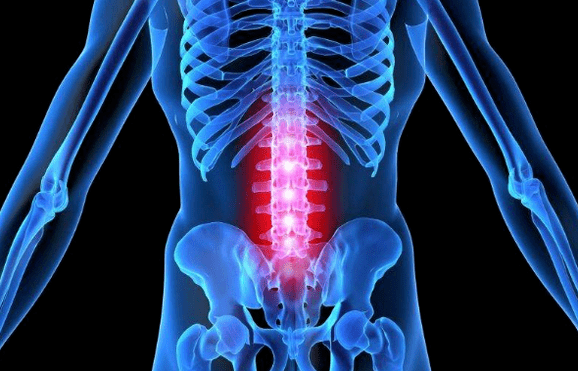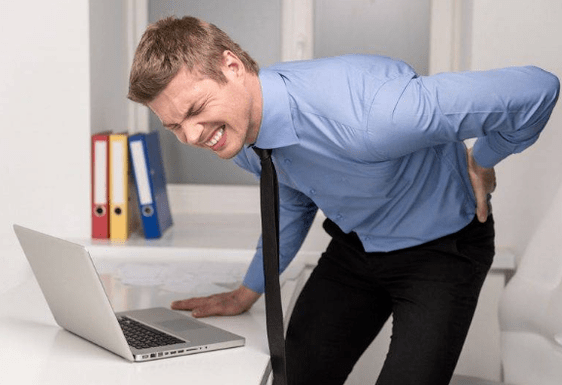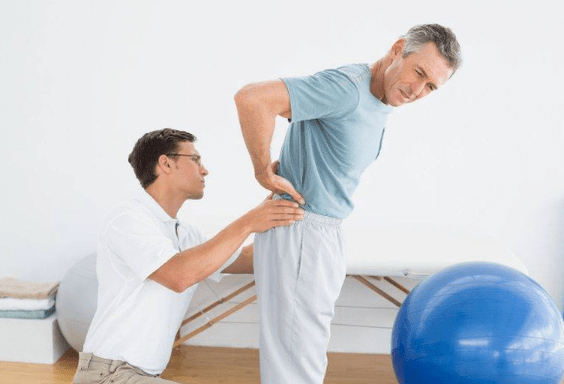People in the lower back affect the most common after 35 years.In most cases, the disease is connected to the deformation of the vertebrae and their consequences.The timely attractiveness of the doctor accelerates recovery because the symptoms and the treatment of osteochondrosis of the lumbar spine are connected.

The greater the progress of the disease, the more serious the consequences, the more difficult the process of restoring health.
Signs and symptoms of an osteochondrosis of the lumbar spine
The lumbar region is located between the sacrum and the breast department and consists of five vertebrae connected by intervertebral discs.
The development of osteochondrosis means the wear of the intervertebral discs, which play a shock -absorbing role in loads on the spine.The basis of the panes is a gel -like mass that is protected by a dense fibrous ring and cartilage, and the interior is filled with a liquid pulp core.
If the loads of vertebrae are lost the elasticity and flexibility of the intervertebral discs, microrises are formed like their size, and in the fibrous ring, microrises are formed that lead to a break and damage to the pulp core over time.
The destruction of tissues is accompanied by nerve roots on both sides of the vertebrae and causes severe pain.
The main signs of lumbar osteochondrosis:
- Back pain;
- Fatigue and depression;
- Weakness or excessive muscle tension;
- Loss of sensitivity in the limbs, buttocks or hips;
- Acute or painful pain and cramps in the lower back, which often give the legs;
- Violation of the motor function.
Against the background of serious vertebra lesions, other symptoms in the lumbar area are also observed, mostly a functional disorder of other organs - the urinary and sexual system, the stomach intestine tract.
Causes
Like most diseases of the musculoskeletal system, osteochondrosis can develop for many reasons.Some of them are lifestyle and diet, the other part develops against the background of the physiological characteristics of the body.
Very often, the treatment of osteochondrosis of the lumbosacral spine of athletes is required, the back of which is not only exposed to constant power burdens, but also in the case of regular injuries.
The second category of people who are at risk, people who spend a lot of time in one position due to their profession - teachers, hairdressers, chefs, loaders, waiters, programmers, office workers and drivers.
Among other things, causes of the development of pathology:
- Obesity;
- Violation of the metabolism;
- Improper attitude, Boop;
- genetic predisposition;
- Injuries;
- bad habits;
- Lack of advantageous trace elements and vitamins in diet;
- Abnormal development of the muscle bone system, flat feet;
- Settlement;
- sedimentary, static;
- Frequent loads.
All of the factors listed can influence the elasticity of the intervertebral discs of the intermediate disc, since they contribute to a violation of the blood circulation or the occurrence of a lack of nutrients that occur in the vertebrates.
Osteochondrosis of the lumbar spine
Depending on the damage to the spine, the four degrees of development are differentiated from osteochondrial processes that manifest in stadiums when the disease develops.
The first degree.
Pathological processes in the spine begin long before their first clinical manifestation.As a result, moisture losses between vertebral slices are less elastic elastic.The height of the discs is stored normally.The patient feels uncomfortable in the lower back.
The second degree.
Against the background of the lack of moisture, microreters occur in the fibrous ring and tissue infections arise.The hooks of the vertebrae gradually increase.There are seals in the cartilage.The patient complains about back pain and gives his feet or her groin area.It is possible to limit motor functions.Errors occur in the work of internal organs.
The third degree.
The integrity of the fibrous ring is disturbed, the intervertebral disc is over, which forms a hernia.Vessels and nerve ends are compressed.Muscle cramps, functional disorders of the pelvic organs, a sensitivity disorder of the lower extremities, longer radiculitis attacks.
The fourth degree.
The most complex, not accessible for treatment, stage during the disease.As a result of the complete destruction of the intervertebral discs, scars are formed in their place.The vertebrae are maximum close and gradually deformed.With the development of the compression of the spinal cord, paralysis of the lower extremities is possible.
Diagnosis
In order to recognize the disease and determine the exact diagnosis, neurologists use a complex of measures - a history of anamnesis, physiological studies and hardware studies.

Hang -up collection.
Provides the examination of the patient's symptoms:
- The cause of fear;
- Place of localization of complaints;
- Duration and intensity of unpleasant sensations;
- The duration of the disease;
- possible causes of the disease;
- Frequency of deterioration;
- Factors that provoke exacerbations;
- Factors that improve well.
In addition, the doctor examines information about the patient's lifestyle, nutrition, work and calm, the presence of bad habits, hereditary factors and injuries.
Physiological examination.
It is carried out to determine pathological changes and make a preliminary diagnosis.
During the examination, the doctor evaluates the patient's motor skills - attitude, amplitude and movement volume.The palpation method examines the condition of the muscles - sound, size, volume of the cramps.It sets the level of sensitivity with minor tingling.Singing with a hammer enables the area of radiation to find out pain.
Hardware research
In order to obtain complete and accurate information about the location of the pathology and the degree of tubs, doctors use research over different types of medical devices.
Radiography.By examining the lumbar industry by an X beam, we can determine anatomical parameters of the vertebrae and intervertebral discs, the tendency, the holes between the bases, to increase the presence of bone growth.
Tomography.The use of electromagnetic waves provides the output of the image of the examined area on the screen for further examination and analysis of the condition of the blood vessels, which feed the tissue of the spine, nerve processes and intervertebral discs.
Ct.Images of several spine segments are carried out using X radiation.The image is displayed on the monitor to determine the type of changes in the vessels, the membrane of the vertebrae and spinal cord and regional growth.
Various types of studies are used for differential diagnostics to eliminate pathologies of other body systems.
Treatment of osteochondrosis of the lumbosacral spine
The duration and features of the treatment of lumbosacral osteochondrosis depend on the results of diagnostic measures.Conservative treatment is displayed in the early stages of the development of the disease.Surgical intervention is used for more complex lesions of the spine.
The optimal therapeutic effect is achieved through complex therapy that provides for the use of local medication, physiotherapy, massage and healing gymnastics.
Drug treatment
In order to relieve symptoms, non -steroid medicines for internal and external use are prescribed - tablets, injections, ointments.In addition, chondroprotectors, neuroprotectors, diuretics, vitamins and muscle relaxants are used.
Drug treatment allowed:
- Eliminate pain;
- Remove inflammation;
- Relax muscles;
- Restore the destroyed cartilage;
- Improvement of blood circulation;
- Reduce swelling;
- increase physical activity;
- Normalize the nutrition of the brain.
In the event of acute pain, novocaine blocks that provide an immediate effect are used.
Folk remedy
Treatment with folk methods is effective as an additional drug for drug therapy.The main techniques of traditional medicine are based on the use of plant materials, animal products and chemicals.
Based on various components, ointments and compresses, decocements and infusions are made for internal and external use as well as for therapeutic baths.
Physiotherapy for lumbar osteochondrosis
Physiotherapeutic methods are a great way to restore the motor functions of the spine after damage to osteochondrosis.
The most important physiotherapeutic methods include:
- Electrotherapy - exposure to weak electrical currents to improve blood circulation in the tissue;
- Magnetotherapy - the use of magnetic fields to restore tissues at cellular level;
- Laser therapy - comprehensive activation of biological processes in vertebrates and nerveenders;
- Shop wave therapy-to-improving the microcirculation and metabolic processes in affected tissues by the effect of an acoustic wave;
- Balneotherapy - the use of the healing properties of mineral water.

Physiotherapy methods not only increase the effectiveness of drug treatment several times, but also contribute to the healing and strengthening of the entire body.
Massage for osteochondrosis of the lumbar spine
Massage methods are one of the most pleasant and effective methods for the treatment of osteochondrosis.
Use the therapeutic massage:
- Eliminate muscle cramps;
- Improvement of blood supply to the affected areas;
- improve the outflow of lymph;
- Restore muscles that have exposed atrophy;
- Remove mobility restriction.
The massage is prescribed when pain syndromes are eliminated.
Therapeutic gymnastics
The main task of training therapy for osteochondrosis is to restore the functionality of the spine and its correction.However, you can only take part in the lessons after the symptoms have been removed.
The most effective methods of therapeutic exercises are taken into account:
- Charger;
- Visit to the gym;
- Water therapy, swimming.
At home you can use a tire for sports.Some doctors to restore the flexibility of the spine recommend their patients yoga lessons.
Excessive osteochondrosis exercises
All exercises for osteochondrosis must be carried out slowly and without sudden movements.
To strengthen the muscles that support the vertebrae, the exercises on the stomach approached.In this case, the hands are stretched with a slight sip, but without tension.Repeat 4 times.
Surgical intervention
In particularly difficult cases, they fall back on the treatment of the spine - with significant neurological diseases and in the event of a loss of control over intestinal movements.
In the course of the surgical intervention, removal of the disease control is ensured and measures are carried out to stabilize the spine.The postoperative period takes several months.
Why is lumbar osteochondrosis dangerous?
Degenerative changes that occur in the lumbar osteochondrosis contribute to the development of many diseases that are dangerous for human life.Against the background of the intermediate umbrellas, the lead, Lumbago and Ishias.
Another progress of the disease can lead to the intervertebral disc and the formation of Spinoz.In addition to severe pain that accompany pathologies, a person's motor skills are violated by them until they are completely lost.The paralysis of the lower extremities develops.
Death is inevitable with considerable damage to the membrane of the spinal cord.
prevention
To avoid destructive changes in the spine, you have to take care of a healthy lifestyle:
- Do sports - swim, harden;
- Adhere to the right, balanced, good nutrition;
- Exclude bad habits;
- Keep attitude;
- Support the spine in sleep with an orthopedic mattress.
In addition, it is advisable to avoid hypothermia and lifting weight.Women are not recommended to wear high shoes often.
You can maintain lumbar health if you adapt your lifestyle and do not forget the importance of physical activity.




















